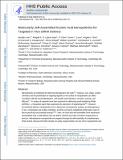| dc.contributor.author | Sehgal, Alfica | |
| dc.contributor.author | Querbes, William | |
| dc.contributor.author | Zurenko, Christopher S. | |
| dc.contributor.author | Jayaraman, Muthusamy | |
| dc.contributor.author | Peng, Chang G. | |
| dc.contributor.author | Charisse, Klaus | |
| dc.contributor.author | Borodovsky, Anna | |
| dc.contributor.author | Manoharan, Muthiah | |
| dc.contributor.author | Donahoe, Jessica S. | |
| dc.contributor.author | Truelove, Jessica | |
| dc.contributor.author | Nahrendorf, Matthias | |
| dc.contributor.author | Lee, Hyuckjin | |
| dc.contributor.author | Lytton-Jean, Abigail K. R. | |
| dc.contributor.author | Chen, Yi | |
| dc.contributor.author | Love, Kevin T | |
| dc.contributor.author | Park, Angela I. | |
| dc.contributor.author | Karagiannis, Emmanouil | |
| dc.contributor.author | Langer, Robert S | |
| dc.contributor.author | Anderson, Daniel Griffith | |
| dc.date.accessioned | 2017-02-03T21:56:38Z | |
| dc.date.available | 2017-02-03T21:56:38Z | |
| dc.date.issued | 2012-06 | |
| dc.date.submitted | 2011-10 | |
| dc.identifier.issn | 1748-3387 | |
| dc.identifier.issn | 1748-3395 | |
| dc.identifier.uri | http://hdl.handle.net/1721.1/106860 | |
| dc.description.abstract | Nanoparticles are used for delivering therapeutics into cells. However, size, shape, surface chemistry and the presentation of targeting ligands on the surface of nanoparticles can affect circulation half-life and biodistribution, cell-specific internalization, excretion, toxicity and efficacy. A variety of materials have been explored for delivering small interfering RNAs (siRNAs)—a therapeutic agent that suppresses the expression of targeted genes. However, conventional delivery nanoparticles such as liposomes and polymeric systems are heterogeneous in size, composition and surface chemistry, and this can lead to suboptimal performance, a lack of tissue specificity and potential toxicity. Here, we show that self-assembled DNA tetrahedral nanoparticles with a well-defined size can deliver siRNAs into cells and silence target genes in tumours. Monodisperse nanoparticles are prepared through the self-assembly of complementary DNA strands. Because the DNA strands are easily programmable, the size of the nanoparticles and the spatial orientation and density of cancer-targeting ligands (such as peptides and folate) on the nanoparticle surface can be controlled precisely. We show that at least three folate molecules per nanoparticle are required for optimal delivery of the siRNAs into cells and, gene silencing occurs only when the ligands are in the appropriate spatial orientation. In vivo, these nanoparticles showed a longer blood circulation time (t[subscript 1/2] ≈ 24.2 min) than the parent siRNA (t[subscript 1/2] ≈ 6 min). | en_US |
| dc.description.sponsorship | National Institutes of Health (U.S.) (Grant EB000244) | en_US |
| dc.description.sponsorship | Alnylam Pharmaceuticals (Firm) | en_US |
| dc.description.sponsorship | National Research Foundation of Korea (Grant NRF-2011-357-D00063) | en_US |
| dc.description.sponsorship | National Institutes of Health (U.S.) Centers of Cancer and Nanotechnology Excellence (Grant U54 CA151884) | en_US |
| dc.language.iso | en_US | |
| dc.publisher | Nature Publishing Group | en_US |
| dc.relation.isversionof | http://dx.doi.org/10.1038/nnano.2012.73 | en_US |
| dc.rights | Article is made available in accordance with the publisher's policy and may be subject to US copyright law. Please refer to the publisher's site for terms of use. | en_US |
| dc.source | PMC | en_US |
| dc.title | Molecularly self-assembled nucleic acid nanoparticles for targeted in vivo siRNA delivery | en_US |
| dc.type | Article | en_US |
| dc.identifier.citation | Lee, Hyukjin et al. “Molecularly Self-Assembled Nucleic Acid Nanoparticles for Targeted in Vivo siRNA Delivery.” Nature Nanotechnology 7.6 (2012): 389–393. | en_US |
| dc.contributor.department | Harvard University--MIT Division of Health Sciences and Technology | en_US |
| dc.contributor.department | Massachusetts Institute of Technology. Department of Chemical Engineering | en_US |
| dc.contributor.department | Koch Institute for Integrative Cancer Research at MIT | en_US |
| dc.contributor.mitauthor | Lee, Hyuckjin | |
| dc.contributor.mitauthor | Lytton-Jean, Abigail K. R. | |
| dc.contributor.mitauthor | Chen, Yi | |
| dc.contributor.mitauthor | Love, Kevin T | |
| dc.contributor.mitauthor | Park, Angela I. | |
| dc.contributor.mitauthor | Karagiannis, Emmanouil | |
| dc.contributor.mitauthor | Langer, Robert S | |
| dc.contributor.mitauthor | Anderson, Daniel Griffith | |
| dc.relation.journal | Nature Nanotechnology | en_US |
| dc.eprint.version | Author's final manuscript | en_US |
| dc.type.uri | http://purl.org/eprint/type/JournalArticle | en_US |
| eprint.status | http://purl.org/eprint/status/PeerReviewed | en_US |
| dspace.orderedauthors | Lee, Hyukjin; Lytton-Jean, Abigail K. R.; Chen, Yi; Love, Kevin T.; Park, Angela I.; Karagiannis, Emmanouil D.; Sehgal, Alfica; Querbes, William; Zurenko, Christopher S.; Jayaraman, Muthusamy; Peng, Chang G.; Charisse, Klaus; Borodovsky, Anna; Manoharan, Muthiah; Donahoe, Jessica S.; Truelove, Jessica; Nahrendorf, Matthias; Langer, Robert; Anderson, Daniel G. | en_US |
| dspace.embargo.terms | N | en_US |
| dc.identifier.orcid | https://orcid.org/0000-0003-0131-6552 | |
| dc.identifier.orcid | https://orcid.org/0000-0003-4255-0492 | |
| dc.identifier.orcid | https://orcid.org/0000-0001-5629-4798 | |
| mit.license | PUBLISHER_POLICY | en_US |
